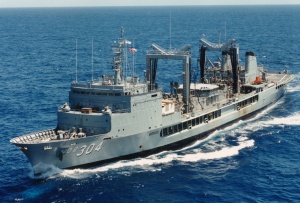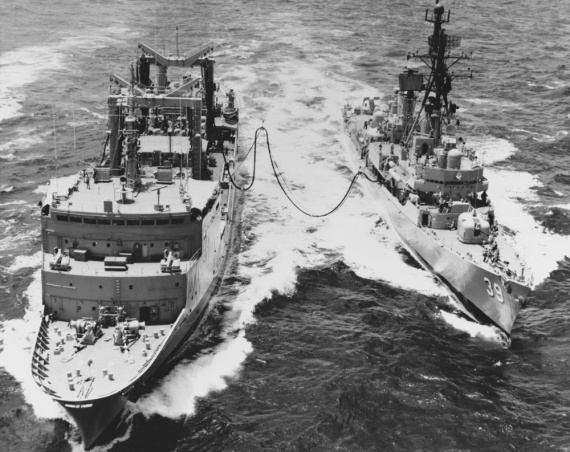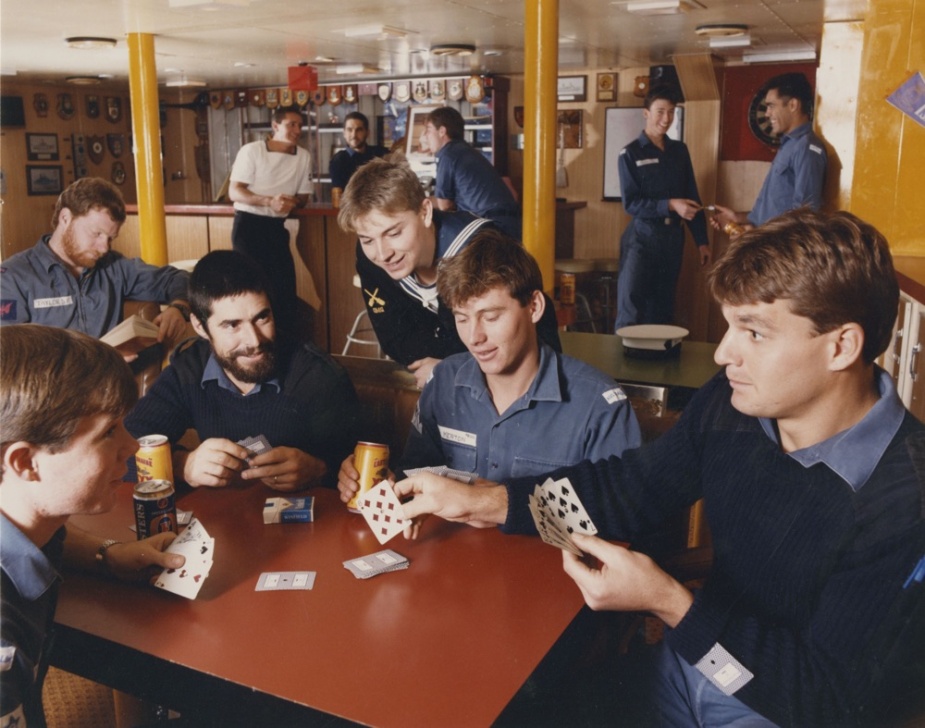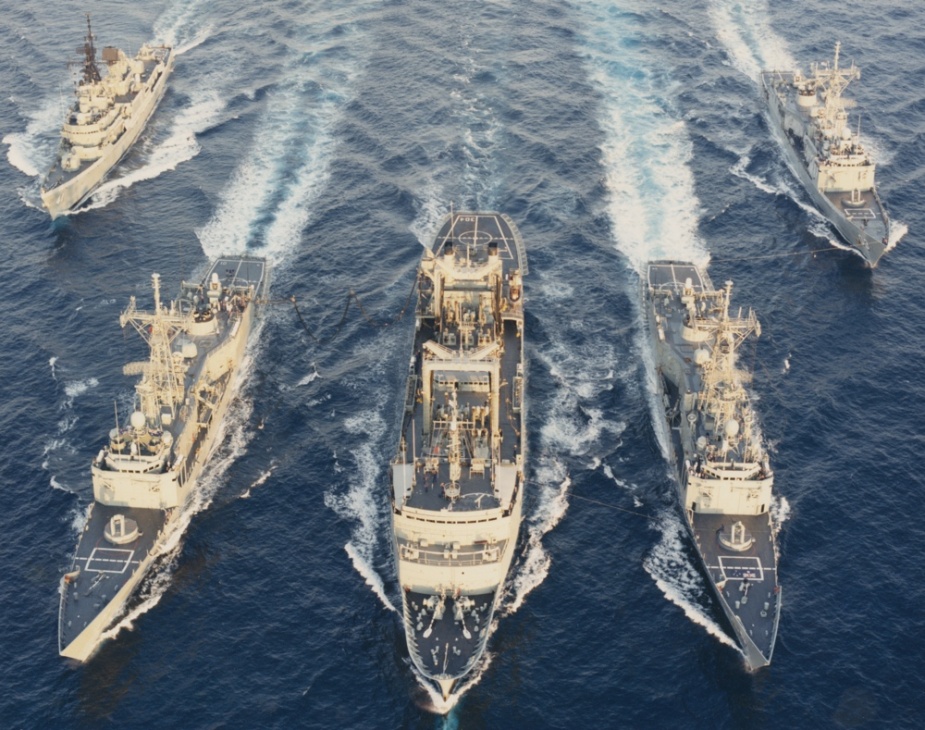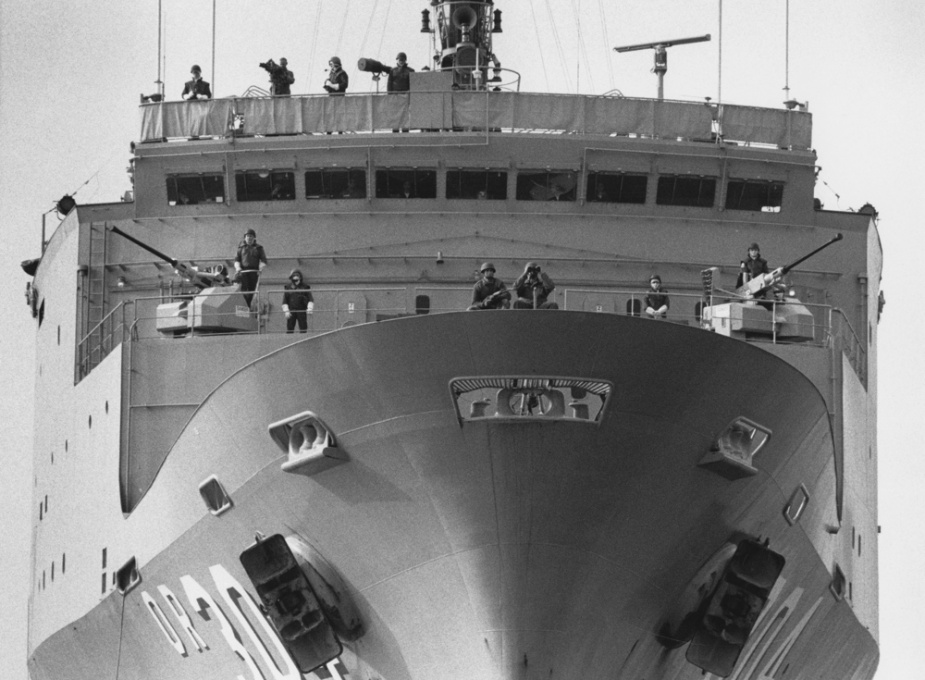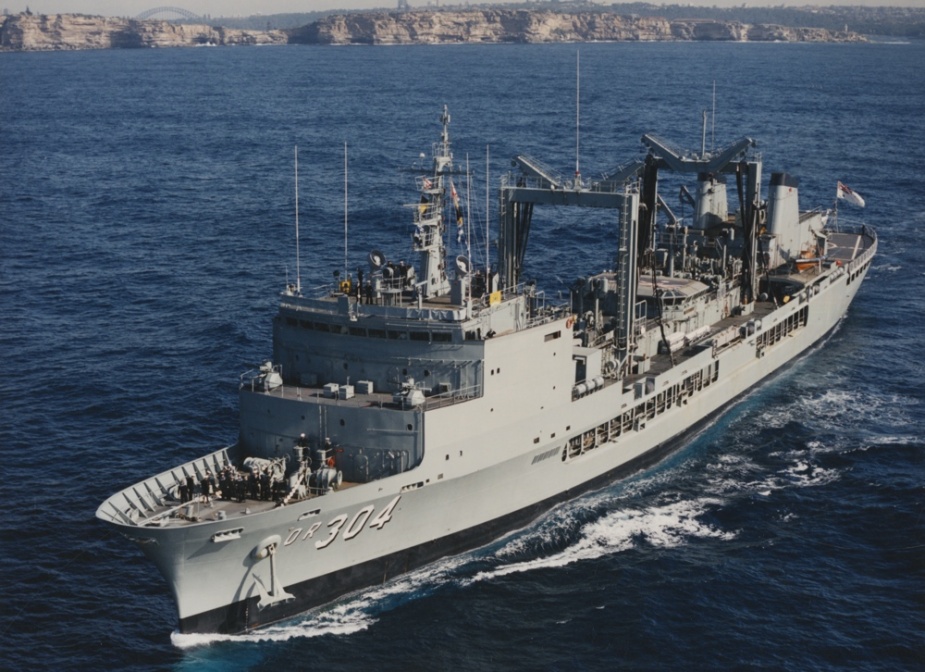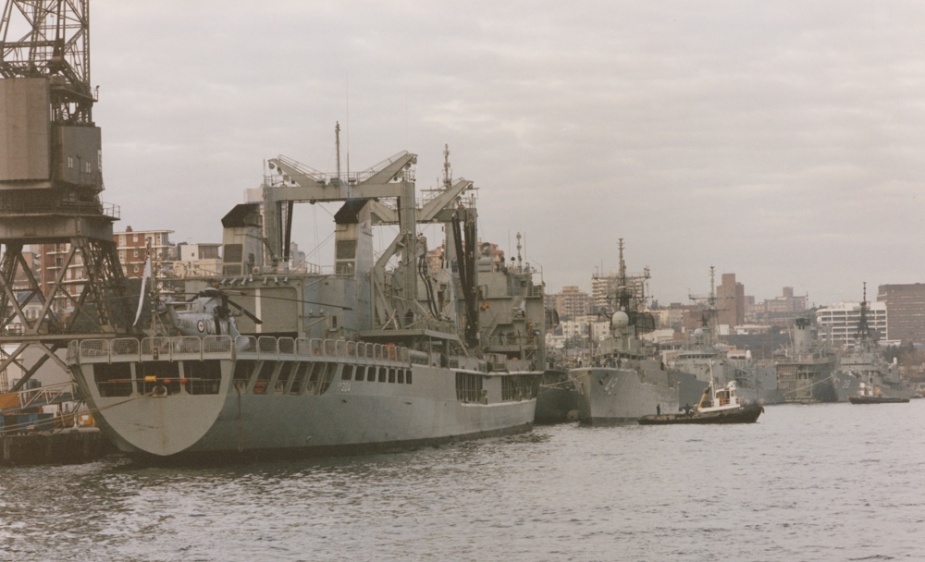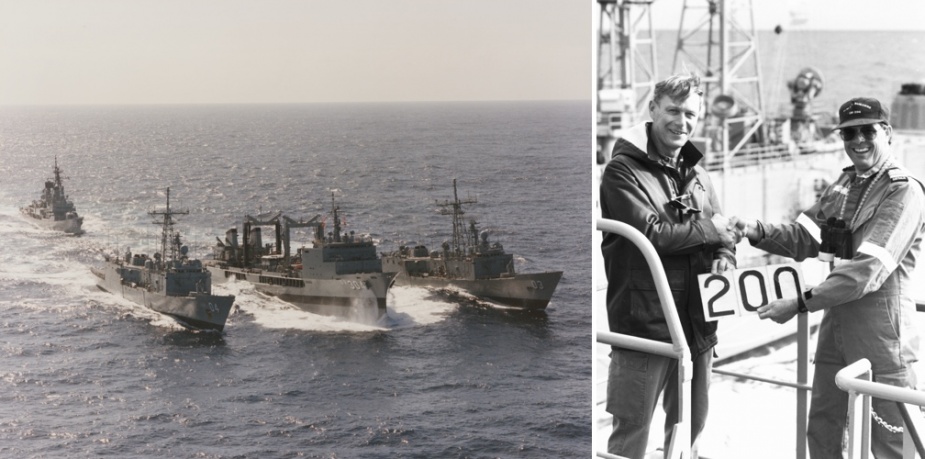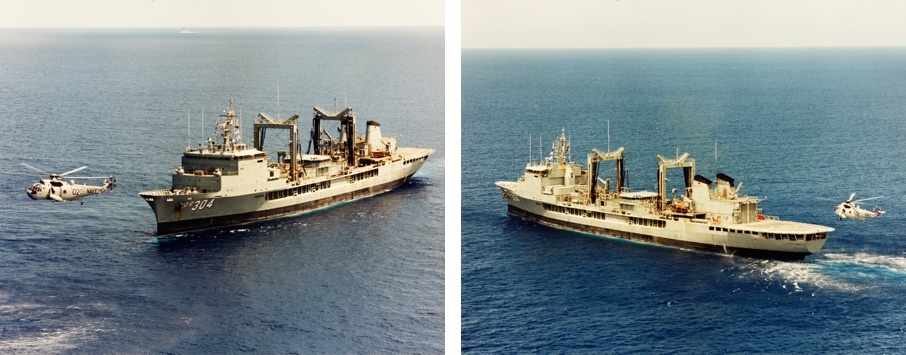HMAS Success (II) - Part 2
| Type | |
|---|---|
| Role | Combat Logistics |
| Pennant |
OR 304 |
| International Callsign |
VLNN |
| Motto |
Strive To Win |
| Home Port | |
| Builder |
Cockatoo Island Dockyard, Sydney, NSW |
| Laid Down |
9 August 1980 |
| Launched |
3 March 1984 |
| Launched by |
Her Excellency Lady Stephen, wife of the then Governor-General of Australia |
| Commissioned |
23 April 1986 |
| Decommissioned |
29 June 2019 |
| Dimensions & Displacement | |
| Displacement | 18,000 tonnes (full load) |
| Length | 157.2 metres |
| Beam | 21.2 metres |
| Draught | 8.6 metres |
| Performance | |
| Speed | 20 knots |
| Range | 8600 nautical miles |
| Complement | |
| Crew | 220 |
| Propulsion | |
| Machinery | 2 x SEMT-Pielstick 16 diesels |
| Armament | |
| Guns |
|
| Radars | 2 x Kelvin Hughes Type 100G |
| Helicopters |
|
| Awards | |
| Battle Honours | |
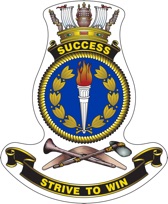
1989
She returned to sea on 23 January 1989 for shakedown and workup exercises before participating in the first Fleet Concentration Period of the year in February, and conducting port visits to Brisbane, Newcastle, Melbourne and Hobart in February and March. The ship was dry-docked in Newcastle for maintenance in April and May. She returned to Sydney on 17 May and recommenced a routine program of exercises, training and maintenance the following month.
She participated in Exercise SPLASHDOWN in June in which she acted as a target and training facility for the SAS Regiment and 5 Squadron RAAF. Later in the month the ship visited New Zealand and Samoa where members of the ships company undertook two civil aid tasks; the transfer of personnel and equipment by the ship’s helicopter to remote survey sites on the island of Savai’i, and the installation of two diesel-powered generators, refrigeration units and lighting at the health centre in the village of Sauano. She went on to visit American Samoa and Papua New Guinea in July before proceeding towards Darwin, conducting exercises with other RAN and USN units en route.
27 July, the day before arrival in Darwin, was not a good day for Success. While alongside HMAS Dubbo (II) to embark mail, one of Success’ rigid inflatable boats (RIB) capsized sending the boat’s three-person crew and around 35 bags of mail into the water. Dubbo’s ship’s boat recovered the crew unharmed while Success manoeuvred to recover the RIB and mail with the ship’s crane. Five bags of mail, all bound for USS Oldendorf, were lost. Later the same morning, having just completed a personnel transfer, Success’ Wessex helicopter experienced ground resonance, a dangerous imbalance in the helicopter’s rotor, while lashed to the flight deck. The port side lashings broke before the aircrew could shut the aircraft down causing it to tip to port and the rotor blades struck the deck. It then settled heavily breaking the port undercarriage. No personnel were injured but the aircraft suffered extensive damage.
Those two unfortunate incidents did not, however, effect the ship’s highly successful participation in Exercise KANGAROO 89 in August. She set a new ship’s record for replenishments at sea conducted in a 24 hour period, thirteen, on 6 August and conducted 88 separate replenishments over the course of the 14-day exercise.
Upon the conclusion of KANGAROO, Success joined HMAS Sydney (IV) and US Ships Oldendorf and Robert E Peary for passage to South East Asian waters. Success and Sydney arrived in Singapore on 28 August. Over the course of the next two months, Success visited Manila, Subic Bay, a second stop in Singapore, Port Klang, Phuket and Penang, and conducted exercises with navy and air force units from the USA, the Philippines, the UK, Malaysia and Singapore as well as Australia in various parts of the Malacca Straits and the South China Sea. On 23 September, while en route from Subic Bay to Singapore, Success and Sydney discovered the wreckage of what appeared to be a fishing or, possibly, refugee vessel with, tragically, several bodies in the water. Success remained in the area overnight conducting recovery operations while Sydney continued on to Singapore to participate in the Major Integrated Air Defence Exercise 89-4. Success joined the exercise on the 26th and the following day, the 14 bodies earlier recovered in the South China Sea were buried at sea.
On 18 October, the Commanding Officers of both Success and Sydney, Captain Graham Sloper, RAN, and Commander Russ Shalders, RAN, respectively, met His Royal Highness, Prince Philip, Duke of Edinburgh, KG, KT, OM, GBE, AC, QSO, on the wharf in Phuket while on his official tour of Thailand. Success and Sydney parted company on 27 October as Sydney returned to Australia and Success proceeded to Singapore for a scheduled maintenance period. She departed Singapore on 17 November and arrived back in Sydney, via Geelong, on 1 December for well-earned Christmas leave.
1990
Success’ program for January 1990 was affected by industrial disputes on Sydney’s waterfront. An ammunition top up scheduled for the 19th was cancelled and the delivery of parts necessary to complete repairs to the ship’s port main engine exhaust bellows was delayed, which resulted in the cancellation of shakedown exercises and a programmed visit to Newcastle over the Australia Day weekend. She eventually put to sea on the 29th to participate in a Fleet Concentration Period in New Zealand waters involving Navy and Air Force units from Australia, New Zealand and Canada. Exercises were curtailed, however, due to the intensification of the civil war on Bougainville Island and the passage of Tropical Cyclone Ofa through Western Samoa resulting in the re-tasking of RAN and RNZN units and a consequent increase in the tempo of replenishments by Success. She arrived back in Sydney on 23 February and began preparing for her upcoming RIMPAC deployment.
Part of the period alongside was used to establish a matriculation external studies program on board for 42 students from Success and the other three ships of the RIMPAC Task Group (TG), HMA Ships Brisbane, Darwin and Adelaide, in conjunction with NSW TAFE and under the direction of Success’ Training Management Officer. The program allowed personnel to gain secondary qualifications without reducing their deployment availability.
The TG departed Sydney on 26 March and arrived in Hawaii on 8 April. RIMPAC exercises occupied most of April and May and Success departed Hawaiian waters on 5 June. She arrived back in Sydney, via Noumea, on 21 June where she entered a leave and maintenance period. During this time the ship underwent flight deck upgrades to enable her to embark the RAN’s new Sea King helicopters. She returned to sea on 6 August to commence shakedown and workup exercises and visited Melbourne on the 9th.
Operation DAMASK I
Shortly before midnight on 9 August Success received advice that she was to return to Sydney at best speed to prepare to deploy to the Persian Gulf in support of Operation DAMASK following the Iraqi invasion of Kuwait the previous week. A number of temporary accommodation modules which had been installed for the ship’s cancelled participation in Exercise SANDGROPER were retained in order to accommodate a large number of additional personnel. Following a hectic weekend preparing and storing ship she departed Sydney on 13 August after being farewelled by the Prime Minister, the Honourable Bob Hawke, MP, and other VIPs including the Chief of Naval Staff, Vice Admiral Michael Hudson, AC, RAN.
Success rendezvoused with HMA Ships Darwin and Adelaide (II) on 15 August and henceforth the group was designated Task Group 627.4 (TG 627.4). An intensive exercise program was initiated as the TG progressed towards Western Australia Focussing on anti-air warfare, damage control, and nuclear, biological and chemical weapons defence, assisted by the RAAF and Fleet Support Services Learjets. Members of the Sea Training Group (collectively known as the ‘wreckers’), under the direction of Commodore Flotillas, Commodore Don Chalmers, RAN, were embarked to oversee the training using Success as their ‘home base’ to re-group at the end of the day’s training. An overnight visit to HMAS Stirling was made on 21/22 August before commencing the passage across the Indian Ocean and continuing intensive exercises en route. Among the final preparations made at Stirling was the embarkation of eight soldiers from 16 Air Defence Regiment and two RBS70 mobile missile systems to augment Success’ anti-air capability.
With Commodore Chalmers now appointed Commander Task Group (CTG) 627.4 and embarked in Success, TG 627.4 entered the Middle East Area of Operations (MEAO), via Diego Garcia, on 3 September joining the Multi-National Naval Force (MNNF) which would eventually include warships from 15 nations. After a brief visit to Muscat, Success’ MNNF replenishment operations commenced on the 7th while interrogating up to 30 merchant vessels per day. In addition to replenishment operations with the ships of the MNF, and interrogation of merchant vessels, Success also served as a training platform for boarding parties posing as a merchant vessel with the pseudonym, Al Fatigue. Success’ operational tempo was high conducting replenishment operations and exercises with MNNF vessels from many different navies, as well as her own patrol operations. In November Captain Sloper reported “Success continues to operate like a fine clock, quietly and unobtrusively.”
Darwin and Adelaide were relieved by HMA Ships Brisbane (II) and Sydney (IV) in December, and Commodore Chalmers was relieved as CTG by Commodore Chris Oxenbould, RAN, who embarked in Brisbane. As Success steamed south towards the Seychelles for Christmas, the ship received a signal advising that she had been awarded the Duke of Gloucester’s Cup as the RAN unit displaying the highest level of overall proficiency in 1990. It was a year in which the ship set a new record for replenishments at sea, 356, steamed the equivalent of two circumnavigations of the world at the equator, and refuelled ships from the USA, Canada, New Zealand, South Korea, the Netherlands, the UK and Australia. Success won the RAN’s most prestigious award twice more, in 1999 and 2014.
1991
The ship re-entered the MEAO on 29 December and re-commenced DAMASK operations in the New Year.
On 30 November 1990 the United Nations Security Council had adopted Resolution 678 authorising the use of force against Iraq unless it withdrew from Kuwait by 15 January 1991. In the days leading up to the deadline, Success was moved to an area in the Southern Arabian Gulf known as the Combat Logistics Force holding area where she could conduct replenishments on a ‘racetrack’ or conduct ‘delivery boy’ replenishments in the Northern Arabian Gulf under escort.
The UN deadline of 15 January 1991 passed without incident, but at 02:30 on 17 January Operation DESERT STORM began. The commencement of combat operations had little effect on Success’ replenishment operations, however, and, as Captain Sloper reported “it was very much business as usual on board”. The ship conducted her last replenishments in the MEAO on 22 January before departing on the 25th. She arrived back in Sydney on 8 March, via Singapore, Stirling, and Adelaide where thousands welcomed her back to Australia including Prime Minister Hawke, and where the Governor-General, His Excellency the Honourable Bill Hayden, AC, presented the crew with the Duke of Gloucester’s Cup. Upon her arrival in Sydney she entered a leave and maintenance period, and commenced refit preparations.
Over the ensuing two months the ship was visited by students from no less than five different schools and was used as a training platform for members of the Special Air service Regiment during Exercise ANCHOR CHAIN. On 18 May an alert member of the ship’s duty watch spied two people attempting to break into a car on Mrs Macquarie’s Chair. Leading Seaman Coxswain David McGillivray and three members of the duty watch raced to the scene and apprehended the would-be thieves, holding them until police arrived.
After a series of delays Success was moved into the Captain Cook Graving Dock at Garden Island on 2 August and her refit officially commenced on the 5th. Unfortunately the refit itself also experienced extensive delays caused by technical problems, internal organisational issues with the refit contractor, and industrial action.
1992
Success finally undocked and moved to the North East Fitting Out Wharf on 7 March 1992 and put to sea, for the first time in over 13 months, on 10 April for a week of contractor sea trials. Most of the next five weeks was occupied conducting trials, workup exercises and defect rectification, as well as conducting exercises with RAN and USN units involved in Exercise CORAL SEA.
The most obvious change to the ship as a result of the refit was the four-metre hangar extension to enable the accommodation of a Sea King helicopter considerably enhancing the ship’s capability to conduct vertical replenishment of stores and ammunition. A Sea King was embarked for the first time on 14 April and was manoeuvred around the flight deck, and in and out of the hangar to prove the hangar extension and train deck handlers. Other work included complete overhauls of the main engines and replenishment gear, a refurbished command centre and galley, and extra office space.
On 1 May, Success joined 11 other Australian and American warships, led by the 80,000 ton carrier, USS Independence, for a ceremonial fleet entry and review in Sydney Harbour to commemorate the 50th Anniversary of the Battle of the Coral Sea. Following Independence, Success the led the first group of ships, comprising US Ships Blue Ridge and Mobile Bay, into harbour and, after rounding Bradleys Head, fired a 21-gun salute in honour of the Governor-General, His Excellency the Honourable Bill Hayden, AC, embarked in HMAS Protector (II). The next day a detachment of Success’ ship’s company participated in the Coral Sea March through the streets of Sydney involving some 4000 Australian and American personnel. With Coral Sea commemorations completed, Success returned to sea on 4 May to re-commence workup exercises.
She departed Sydney on 18 May and rendezvoused with HMA Ships Hobart, Adelaide and Canberra bound for the west coast of America to participate in Exercise RIMPAC 92. An intensive exercise program was implemented during the transit including first of class flying trials for the ship’s Sea King flight.
Tragically, in the evening of 28 May, 27 year-old Able Seaman Robert Apps was killed when he fell down a lift well during a major damage control exercise. An experienced, competent, and respected sailor, Apps’ death was a simultaneously devastating, yet galvanising, experience for his shipmates. The Mater Dei School erected a memorial plaque for Able Seaman Apps in its Peace Garden.
The Australian ships arrived in San Diego, via Pearl Harbor, on 19 June. The sea phase of RIMPAC commenced on the 24th and continued for most of July with participating ships in both San Diego and Hawaii. The exercises were marred, however, by a serious accident on 26 June. A high-pressure air-line ruptured while the ship was conducting a replenishment with USS John A Moore lifting Leading Seaman Robert Vijsma three metres off the winch deck, over a guard rail and on to deck below. Medical teams attended the unconscious sailor immediately and he was stabilised on board before being evacuated to Balboa Naval Hospital in San Diego by the ship’s helicopter.
The rest of the exercise proceeded without incident, though the Ship’s Medical Officer was dispatched to render assistance to a civilian yachtsman suffering from prepatellar bursitis, and Success departed San Diego for Australia on 31 July, rendezvousing with Hobart, Adelaide and Canberra the following day. She arrived back in Sydney, via Pearl Harbor, on 27 August and commenced a leave and maintenance period. The cancellation of Success’ participation in Exercise VALIANT USHER meant that she did not return to sea until 12 October but she quickly settled into a routine program of exercises, training and maintenance. Later that month trials involving a 5 Aviation Regiment Blackhawk helicopter proved aircraft and flight deck compatibility.
1993
Success acted as host ship to USS Wabash during the visit of the USS Ranger Battle Group in January 1993 before taking part in a Fleet Concentration Period and Exercise TASMANEX in February. TASMANEX took the participating units cross the Tasman Sea to New Zealand and concluded upon their arrival in Auckland on 25 February.
Success, along with HMA Ships Hobart, Melbourne and Derwent, went on to visit ports in Vanuatu, the Philippines, Singapore and Indonesia while evading the respective paths of Tropical Cyclones Polly and Roger. She participated in Exercise AUSINA in late April and also conducted exercises with naval units from the Philippines, USA and Singapore. She arrived back in Darwin on 6 May where she took part in Exercise KAKADU, upon the conclusion of which she provided support for Helicopter Long Range Sonar trials being conducted by the Defence Science and Technology Organisation. She arrived back in Sydney on 4 June.
Later that month she provided support to HMAS Sydney’s workup in preparation for the frigate’s impending deployment to the Middle East in support of Operation DAMASK. She participated in a Fleet Concentration Period in July which included two consolidation replenishments with HMAS Westralia, the first time that such an evolution had been undertaken between the two tankers.
She took part in Exercise NEW HORIZONS in northern Australian waters in August before heading for South East Asia for the second time that year at the end of the month. She arrived in Singapore on 28 August where she conducted an emergency docking to repair her starboard propeller, damaged when she initiated an emergency breakaway from HMAS Dubbo during NEW HORIZONS and the tow line fouled both her propellers. Repairs were quickly completed and the ship was able to participate fully in Exercise STARFISH which included participants from Australia the UK, New Zealand, Singapore and Malaysia. She arrived back in Sydney, via Darwin, on 1 October where she continued a routine program of exercises, training and maintenance although a persistent hydraulic defect in her steering gear hampered replenishment operations. She entered a maintenance period in November during which the defect was rectified and the first phase of a new radar installation was commenced.

